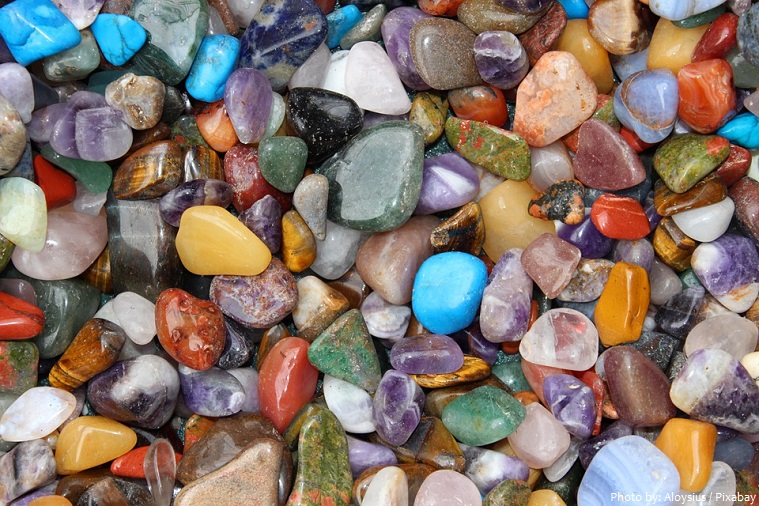Have you ever been enchanted by the natural beauty of gemstones? These precious stones have held mankind in awe for centuries, captivating our imaginations with their brilliant hues and shining facets. They are more than just pretty trinkets, however, and each one has a story to tell. In this post, we'll explore fun and interesting facts about gemstones, how they are formed, and some frequently asked questions about them. So grab your magnifying glass and let's start exploring!
Dazzling Displays of Color
Gemstones come in a rainbow of colors, and the variations are almost endless. From the deep, rich blue of the sapphire to the fiery red of the ruby, to the soft pink of the morganite, each stone has its unique shade and characteristic beauty.

One of the reasons for this is because gemstones are formed deep within the earth, where high temperatures and pressures create the perfect environment for the stones to grow. Minerals such as beryl, corundum, and quartz are just a few of the ingredients needed to create the dazzling displays of color we see in these precious stones.
Formation and Classification of Gemstones
Gemstones are formed in a variety of geological settings including igneous, metamorphic, and sedimentary rock. Each type of rock has its unique qualities and contributes to the formation of different types of gems. For example, igneous rocks such as granite and basalt form deep below the earth's surface and are essential for the formation of some of the most valuable gems like diamonds, rubies, and sapphires.
Metamorphic rocks are created when existing rocks are transformed by heat, pressure, or chemical reactions. This transformation can lead to the formation of gems like garnets, emeralds, and topaz. Lastly, sedimentary rocks like limestone and sandstone can produce gems such as opals and agates.

Gemstones are classified based on their physical, optical, and chemical properties. For instance, diamonds are classified based on their hardness, conductivity, and transparency, while emeralds are classified based on their color, clarity, and refractive index. Knowing these properties is essential in determining the value and quality of a gemstone.
About Gemstones
Gemstones have captivated human imagination for centuries. Not only are they visually stunning, but they also possess a certain mystical quality that is almost irresistible. Here are some interesting facts about gemstones that you may not know:
- Opals are the only gemstone that contains water in their crystalline structure.
- The largest diamond ever found was the Cullinan diamond, weighing 3106 carats and valued at over $2 billion.
- Fluorite is known for its ability to change colors under different light sources.
- The Hope Diamond is said to be cursed and has a history of bringing misfortune to those who possess it.
- The birthstone for August is peridot, which was believed to have healing properties in ancient times.

Gemstones have also played a significant role in various cultures and religions throughout history. For instance, jade was considered a symbol of royalty and power in ancient China, while the ancient Egyptians used lapis lazuli in their jewelry and artwork. Today, gemstones continue to hold cultural and religious significance in many societies around the world.
Frequently Asked Questions
Q: Why are some gemstones more valuable than others?
A: The value of a gemstone is determined by a variety of factors including its rarity, color, size, and clarity. For instance, diamonds are typically more valuable than other gemstones because they are the hardest natural substance, and their scarcity adds to their desirability. On the other hand, gems like turquoise and tiger's eye are more common and therefore generally less expensive.
Q: Can all gemstones be used in jewelry?
A: While most gemstones can be used in jewelry, some are more fragile than others and require special care to prevent damage. For instance, opals and pearls are relatively soft and can be easily scratched, while emeralds and garnets are more durable and suitable for everyday wear.

Q: How are gemstones graded?
A: Gemstones are graded based on their physical, optical, and chemical properties. Factors like color, clarity, and cut are essential in determining the value and quality of a gemstone. The Gemological Institute of America (GIA) is one of the most reputable organizations that provide grading and certification services for gemstones.
Q: What is a birthstone?
A: A birthstone is a gemstone associated with a particular month or zodiac sign. Each birthstone is believed to possess unique qualities and properties that make them special. For instance, the birthstone for the month of July is ruby, which is believed to symbolize love, passion, and power.
Q: Can gemstones be synthesized or treated?
A: Yes, gemstones can be synthesized, which means that they are produced in a laboratory rather than being naturally occurring. Synthetic gemstones are often cheaper and more abundant than their natural counterparts but may lack the same level of quality and uniqueness. Gemstones can also be treated to improve their color or clarity, which can affect their value and authenticity.
Final Thoughts
Gemstones are truly nature's works of art, each one intricate and unique. From their formation to their cultural significance, there is so much to learn and appreciate about these precious stones. Whether you're a jewelry lover or simply intrigued by the magic of gemstones, we hope this post has given you new insight and appreciation for these stunning creations.
